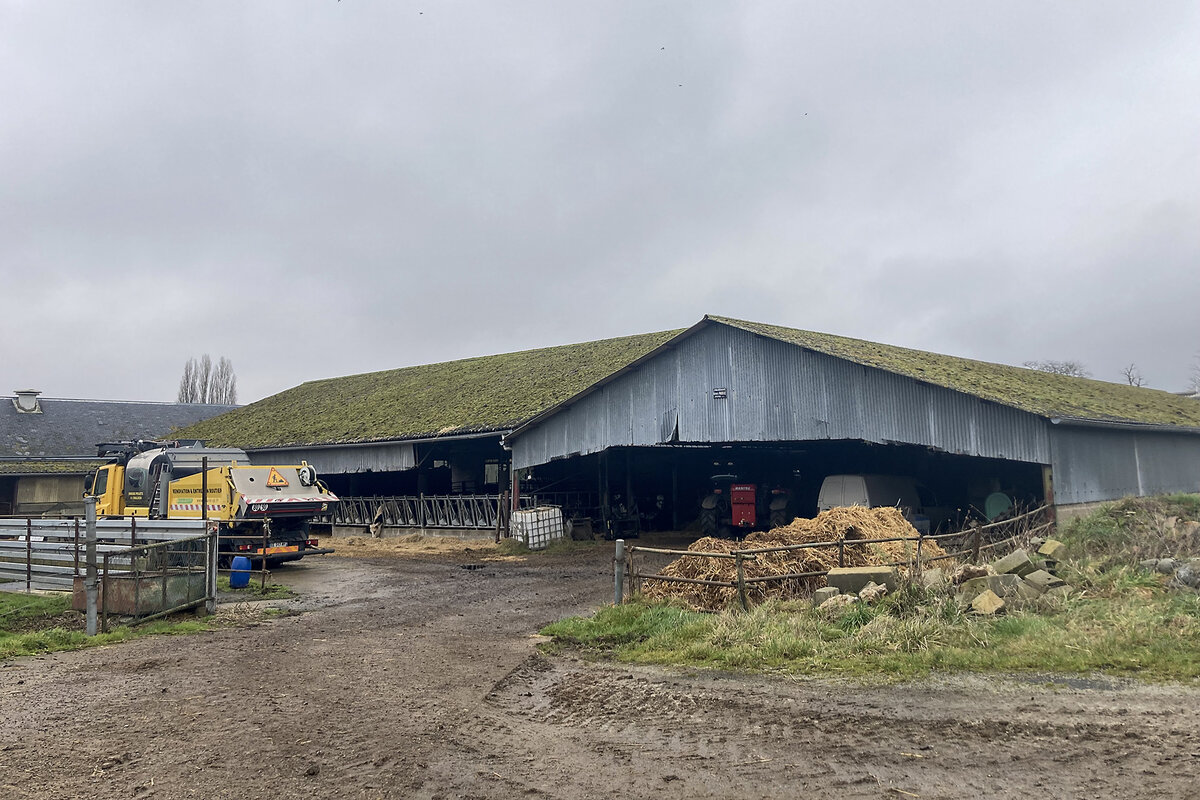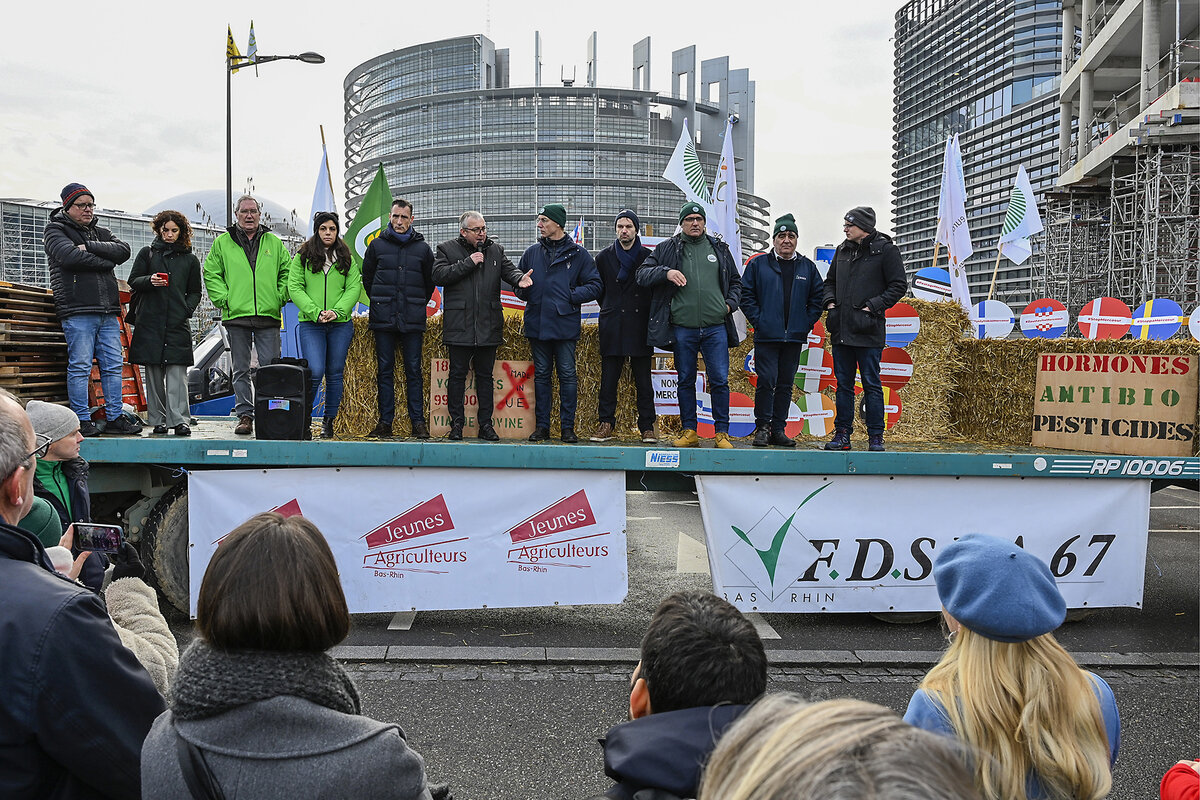Farming in France is on the decline. Who will feed the French?
Loading...
| Houdan, France
Jean-Baptiste Maillier kicks through hay and mud as he passes through the open archway into his barn. Inside, a row of hulking Normande cows is lined up head to tail at the milking machine. After a loud beep, one steps onto a metal plate as a set of white tubes descends onto her teats. Fresh milk pours into a plastic receptacle below her.
Here in Houdan, this scene is increasingly rare. Ten years ago, there were 22 dairy farmers in the area. Now, Mr. Maillier is the only one.
French farmers have grabbed headlines in recent months by blocking roads with hay bales and cow manure. They were out again Monday, in southwestern France, protesting against a trade deal with Latin America that they say would create unfair competition and threaten their livelihoods.
Why We Wrote This
A story focused onFood is a key part of French culture. That means that with French agriculture under threat, the crisis is existential.
But behind that anger, a far bigger crisis is brewing for French farming. Half of all its farmers are expected to retire in the next five years, and few young people are signing up to take their place. At stake is not just the survival of French agriculture but also a key part of what it means to be French: its food culture.
Now, the French must decide how far they are willing to go to keep their diverse terroirs alive, says Jean-Pierre Poulain, a professor emeritus of food culture at the University of Toulouse – Jean Jaurès. As food prices rise and cheap imports crowd local goods off the shelf, “Are they willing to spend more on French-made products instead of buying a new cellphone?” he wonders.
Freedom and fresh air
At the center of this conversation are young farmers like Mr. Maillier.
A decade ago, at age 28, he left his job at a bank near Paris to take over his family farm here in the Eure-et-Loire region, just south of Normandy.
“The freedom, the fresh air – I can be there for my kids when they need me. It’s a no-brainer,” he says, stroking the brown-and-white speckled head of his favorite cow, Philippine.
In a sense, Mr. Maillier is living the classic French dream – working the land in the bucolic countryside, feeding his children good food, and keeping France’s gastronomic heritage alive.
But in 2025, he is an outlier.
“It’s becoming more and more rare, this tradition of passing the farm to the next generation,” says Patrick Le Guillous, who grows wheat and corn a few miles from Mr. Maillier’s farm, and plans to retire next year. “No one wants to put their kids in debt.”
Indeed, farmers – especially vegetable and livestock producers – are more likely to live below the poverty line than the rest of the population, despite working longer hours.
Meanwhile, high land prices make it difficult for new farmers to break into the industry. Instead, farmland is often snatched up by large companies. The result is a drop in the total number of French farms. In 1970, the country counted 1.6 million farms. Today, that number is closer to 400,000.
“I was born into farming and I always wanted to do this. But it’s not an easy job,” says Quentin Le Guillous, secretary-general of the French youth farming union, Jeunes Agriculteurs, and Patrick’s son. “When we go out and protest to say we don’t earn enough, that our working conditions are hard, no one new wants to join us. But if we don’t fight for our rights, who will?”
French farmers have protested sporadically for decades, but they have made headlines most recently by banding together with other European farmers over the last 14 months to oppose the EU-Mercosur (Latin American common market) trade agreement. The deal, negotiated between the European Union and five Latin American countries, would remove tariffs on 90% of goods moving between the two regions, potentially saving the EU around $4 billion in export duties annually.
It was signed in December, but must still be ratified by the EU’s member states. And it continues to stir discontent among French farmers, notably those in beef and poultry, who say cheaper imported meat could price local producers out of the market.
Viande française
Still, for the French, locally produced food remains a source of great pride. They may not be going into farming themselves, but they have overwhelmingly supported recent protests.
On a quaint cobblestone street in Houdan, customers file in and out of the Café de la Paroisse during the lunch rush. On the menu board are the letters “VF” – viande française – to show that its steak tartare and entrecôte are made with meat originating in France.
“If we want to eat well, we have to make good choices,” says owner Karima Cauvin. “That means supporting our farmers.”
Dr. Poulain, the food culture researcher, says the French feel a “real solidarity” with their farmers. This is rooted in a certain pride in their regional terroirs – the most diverse in Europe – and in traditions around food. The Sunday lunch, which often involves lingering over a multiple-course meal with family, is a beloved French ritual. In 2010, UNESCO recognized this style of eating as an essential piece of the world’s intangible cultural heritage.
At the same time, however, the French are spending 13% less of their income on food than they did 60 years ago. And while 90% of people say they want to buy more locally produced food, most say price is the most important factor when choosing what they put in their grocery cart, according to a recent poll.
Still, young farmers are continuing their efforts to get more people interested in agriculture jobs. The Jeunes Agriculteurs organizes parties and tractor races to attract new people to the field. It also holds regular “speed dating” events, pairing would-be farmers with loan officers and union leaders.
Down at Mr. Maillier’s farm, his 7-year-old son, out of school for the day, works with a friend raking up muddy hay from the barn floor.
“Who knows? Maybe they’ll take over the farm one day,” he says of his five children. “But I’m still young. I’m not ready to think about it yet.”








